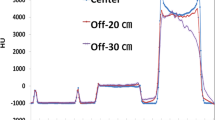Abstract
The purpose of this study was to investigate the risk of overexposure associated with automatic tube current modulation (ATCM) and automatic couch height positioning compensation mechanism (AHC) in computed tomography (CT) systems, particularly in scenarios involving a gap between the subject and the couch. Results revealed that when AHC was enabled, CT dose index volume (CTDIvol) increased by approximately 10% at 2.5 cm, 20% at 5.0 cm, and 40% at 10.0 cm gaps compared to close contact conditions. While the AHC function ensures consistent exposure doses and image quality regardless of subject positioning relative to the CT gantry isocenter, the study highlights a potential risk of overexposure when a gap exists between the subject and the couch. These findings offer valuable insights for optimizing CT imaging protocols and underscore the importance of carefully considering subject positioning in clinical practice.







Similar content being viewed by others
References
Berrington de González A, Darby S. Risk of cancer from diagnostic X-rays: estimates for the UK and 14 other countries. Lancet. 2004;363(9406):345–51. https://doi.org/10.1016/S0140-6736(04)15433-0.
Rizzo S, Kalra M, Schmidt B, et al. Comparison of angular and combined automatic tube current modulation techniques with constant tube current CT of the abdomen and pelvis. AJR Am J Roentgenol. 2006;186(3):673–9. https://doi.org/10.2214/AJR.04.1513.
Namasivayam S, Kalra MK, Pottala KM, Waldrop SM, Hudgins PA. Optimization of Z-axis automatic exposure control for multidetector row CT evaluation of neck and comparison with fixed tube current technique for image quality and radiation dose. AJNR Am J Neuroradiol. 2006;27(10):2221–5.
Li J, Udayasankar UK, Toth TL, et al. Automatic patient centering for MDCT: effect on radiation dose. AJR Am J Roentgenol. 2007;188(2):547–52. https://doi.org/10.2214/AJR.06.0370.
Matsubara K, Koshida K, Ichikawa K, et al. Misoperation of CT automatic tube current modulation systems with inappropriate patient centering: phantom studies. AJR Am J Roentgenol. 2009;192(4):862–5. https://doi.org/10.2214/AJR.08.1472.
Zhang D, Ayala R. Auto couch height positioning compensation–making SURE exposure a smarter dose reduction tool. Toshiba America Medical Systems. 2014;CTWP12271US:1–8.
Kanda Y. Investigation of the freely available easy-to-use software “EZR” for medical statistics. Bone Marrow Transplant. 2013;48(3):452–8. https://doi.org/10.1038/bmt.2012.244.
Kaasalainen T, Mäkelä T, Kortesniemi M. The effect of vertical centering and scout direction on automatic tube voltage selection in chest CT: a preliminary phantom study on two different CT equipments. Eur J Radiol Open. 2018;6:24–32. https://doi.org/10.1016/j.ejro.2018.12.001.
Barreto I, Lamoureux R, Olguin C, et al. Impact of patient centering in CT on organ dose and the effect of using a positioning compensation system: evidence from OSLD measurements in postmortem subjects. J Appl Clin Med Phys. 2019;20(6):141–51. https://doi.org/10.1002/acm2.12594.
Furukawa Y, Matsubara K, Tsutsumi Y. A comparison of automatic and manual compensation methods for the calculation of tube currents during off-centered patient positioning with a noise-based automatic exposure control system in computed tomography. Phys Eng Sci Med. 2021;44(3):823–32. https://doi.org/10.1007/s13246-021-01033-y.
Ishita Y, Urikura A, Yoshida T, Takiguchi K, Ikegaya M. Inaccurate table height setting affects the organ-specific radiation dose in computed tomography. Eur J Radiol. 2022;151: 110317. https://doi.org/10.1016/j.ejrad.2022.110317.
Miyaki A, Yamaguchi K, Kishibe S, et al. Diagnosis of inguinal hernia by prone- vs supine-position computed tomography. Hernia. 2017;21(5):705–13. https://doi.org/10.1007/s10029-017-1640-9.
Kamei N, Koizumi T, Asano T, et al. Evaluation of the utility of supine abdominal CT Imaging with hernia decompression for inguinal hernia (Hernia Study) (in Japanese). Sei Maria Nna Igaku Daigaku Zasshi (Journal of St Marianna University School of Medicine). 2011;38(4):213–9.
Acknowledgements
I extend my sincere gratitude to all my senior colleagues at the hospital whose invaluable guidance and support significantly contributed to this paper. Their wealth of clinical experience and insightful advice greatly influenced my research direction. I am truly thankful for their patient mentorship, thoughtful discussions, and responsiveness to my inquiries, all of which enhanced the depth of this work.
Funding
The authors did not receive support from any organization for the submitted work.
Author information
Authors and Affiliations
Contributions
Conceptualization: Yuta Fujiwara. Methodology: Yuta Fujiwara, Yoshiki Kamihoriuchi, Fumie Higuchi, and Takanori Masuda. Formal analysis and investigation: Yutako Ohyama, Tomoko Sasaki, and Yuta Fujiwara. Writing—original draft preparation: Yuta Fujiwara. Writing—review and editing: Shinichi Nakayama and Takanori Masuda. Project administration: Shinsaku Watanabe. All authors read and approved the final manuscript.
Corresponding author
Ethics declarations
Conflict of interest
All the authors declare that they have no conflict of interest.
Ethical statement
This article did not contain any studies involving human participants.
Consent to participate
Informed consent was obtained from all individual participants included in the study.
Data availability Statement
Raw data were generated at Okayama Central Hospital. Derived data supporting the findings of this study are available from the corresponding author Y.Fujiwara on request.
Additional information
Publisher's Note
Springer Nature remains neutral with regard to jurisdictional claims in published maps and institutional affiliations.
About this article
Cite this article
Fujiwara, Y., Kamihoriuchi, Y., Higuchi, F. et al. Evaluation of overexposure risk when there is a space between the subject and the couch in computed tomography: a phantom study. Radiol Phys Technol 17, 561–568 (2024). https://doi.org/10.1007/s12194-024-00804-y
Received:
Revised:
Accepted:
Published:
Issue Date:
DOI: https://doi.org/10.1007/s12194-024-00804-y




